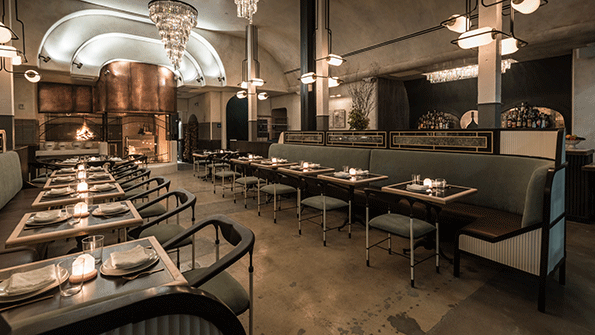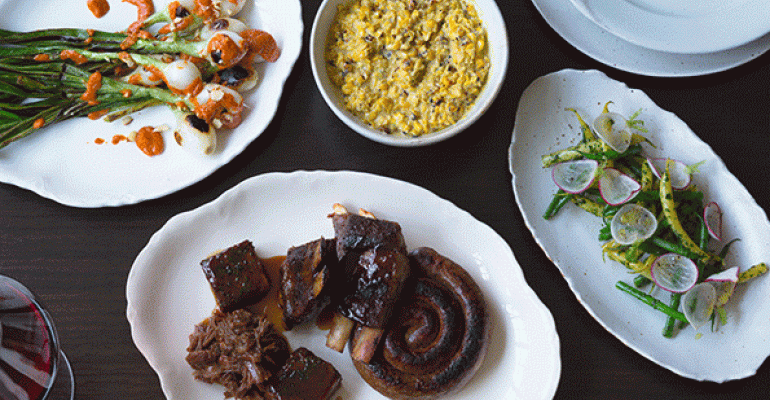
Celebrity chef Curtis Stone recently opened his second restaurant in Los Angeles. Gwen is a combination butcher shop and 80-seat, fine-dining, dinner-only establishment serving a $95 prix-fixe menu.
Stone is running the restaurant with his brother, Luke, who mans the front of the house. Two butchers oversee the in-restaurant butcher shop, and Curtis Stone manages the kitchen.
Although Stone is best known for his television appearances, he is a well established chef who worked for eight years with legendary British chef Marco Pierre White, culminating in the position of executive chef of White’s former flagship restaurant Quo Vadis, in London.
During a recent visit to New York, before Gwen opened, Stone discussed his approach to the restaurant–butcher shop with Nation’s Restaurant News.
You’ve been in Los Angeles for 10 years now. How has the city's restaurant scene changed?
I think L.A.’s gone through this great transition with its restaurants. It was not the most exciting place to eat 10 years ago, unless you wanted a taco or Korean food. It’s really changed drastically since then. But while you can get great produce in the farmer’s market, of course, what hasn’t caught up is seafood, which is still a challenge, and so is meat. So I’m hoping to change a little bit of that with the butcher shop. We’ll become the distributor of this great Australian Wagyu, so we can get it into the shop. We’ve got great relationships with different game reserves in Scotland, so we’ll bring in European game during the season.
Are you going to serve grouse?
Yeah, I love grouse. It’s my favorite bird, actually. But they’ve never had it [in Los Angeles]. Will they buy it? We don’t know.
Americans aren’t typically fans of meat with really assertive flavors, which grouse has.
It sure does, depending on how high [aged] you eat it. But I’m really excited about it, and the benefit of doing the butcher shop and the restaurant together is we can bring things in to the butcher shop and offer them to our guests, but also know that we have an outlet for them through the restaurant.
So there will be less waste.
Hopefully no waste.

You’re going to be one of the few USDA certified butcher shops in the country. Can you bring in whole animals?
We can bring in whole animals, and we can do our own charcuterie. That’s an interesting conversation to have with a health department, when they say your fridges have to run at this temperature and things can’t be out of the fridge for this amount of time, and blah blah blah.
Then you’re like, “Well I’ve got an idea: We’re going to bring in some pork and we’re going to treat it with some salt and we’re gong to hang it in a fridge that’s 20 degrees higher than you suggest and hang it for 18 months and then slice it and serve it raw!”
They’re like, ”No, that doesn’t comply with our rules.”
I’ve heard that restaurants that want to do charcuterie in the U.S. often have to train their health departments about it.
You’re absolutely right. And the benefit is that once you have all of the training [and HACCP plan] in place, they’re like, “Here you go” [and hand you the certification]. Because the more they ask, the more they realize you’re educating them, which is fine. We’re happy to do it, of course.
As long as they’re cool with it.
Right. And you’ve got to continually find out the answers to their questions: Give them the proof that everything’s safe.
How long did it take you to do that?
A number of months. It’s been a process, and a great one for us because we were able to train our team as well. So there’ll be a real close relationship between the butcher shop and the dining room, of course. We’ll butcher whole animals in the shop, but we’ll also cook whole animals in the restaurant. We’ve built a fire pit in there that will do the sort of Argentinean-style grilling. So there will be different things going on in the building, which will make it a bit more interesting.
So the butcher shop will smell great.
Yeah. Imagine that.
We want it to be sort of an old-world place, in many respects. You know, the art of butchery is as old as it gets. An animal gets slaughtered, and then what happens to it before you cook it? It’s obviously happened forever.
But in many ways it’s been lost, because what happens these days is an animal gets killed at an abattoir and it goes to a big processing facility and that piece of meat goes through a nitrogen tunnel and gets the core of it frozen and it goes through a slicing machine, and a lot of that craft skill is lost because as you have less and less people in that industry, then you have less and less people to teach others.
So we want to bring a little bit of that back. From a cook’s perspective, in my mind, there’s something a little lost when you separate [butchery and cooking] so drastically, which is what has always happened, right? A butcher is responsible for cutting meat and selling it, and then a cook is responsible for cooking it, and it’s rare that there’s a real understanding or crossover.
But [a butcher] can treat the meat in a number of different ways to improve its eating quality — dry-aging, tender stretching — and then once the cook gets it there’s other things you can continue to do to improve the eating quality. But the cook and the butcher haven’t crossed over as much. So it’s been cool putting this together.

Right. That was the hardest thing for us to navigate, because where do you put your flag in the sand? Is it grass-fed, is it all-natural, is it organic? Is it this, is it that?
The more we talked about it, the more we came back to what’s the most important thing, and to me, that’s how it eats — whether it’s delicious or not. And it just so happens that when you work with great ranchers and farmers you end up with pretty good natural product. We’ll have a pure grass-fed, and there’s some ups and downs about how people market that — pasture-fed beef is, you imagine, from a cow that walks around in the pasture and eats it. That’s not necessarily the case, because you can buy pasture from somewhere else and give them hay.
But we’ll have a full grass-fed offer. We’re also working with Creekstone, which is finished on grain, and of course the Wagyu is fed an allowance of rye, corn, wheat and a variety of things [including grass].
There’ll be something for everybody, and each thing has its own attributes.
It will be Curtis Stone certified.
Right. Delicious certified, which is the most important thing.
Contact Bret Thorn at [email protected]
Follow him on Twitter: @foodwriterdiary

